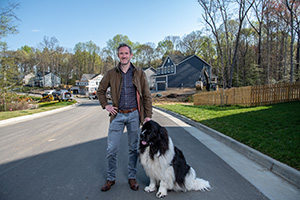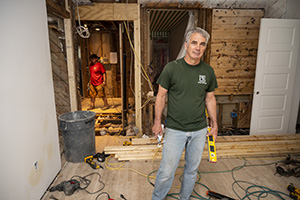Moving out
Construction projects shift to suburbs, rural areas
More than a year after the pandemic began, signs point to people moving away from densely populated city centers, says Anirban Basu, chief economist for Associated Builders and Contractors, an industry trade association based in Washington, D.C.
The construction industry has taken note.
Basu predicts: “This decade will be about the suburbs, with more people and activity leaving cities behind.”
The pandemic has been a big driver of this trend, he says, because telework has increased the opportunity to work miles from densely populated areas. The pandemic also has increased the use of online shopping, often at the expense of brick-and-mortar businesses. Millennials’ expanding search for affordable homes are factors in the shift, too.
“Presumably, Northern Virginia will be a major beneficiary of de-densification, but so will the suburbs of Richmond and Norfolk,” Basu says.

Nationally, residential construction is booming, but commercial real estate fundamentals are weak, according to the economist. “Whether one looks at bankrupt retailers, shuttered restaurants, emptied office suites or under-occupied hotels, the demand for new construction has been diminished by the pandemic.”
The residential market is certainly thriving in Virginia, says Lisa Sturtevant, chief economist for Virginia Realtors, the state trade association. And while retail construction has been hard-hit in the state, “the bright spot has been the industrial market, as the online market has expended. There have been a lot of fulfillment centers and, at the same time, a tremendous amount of construction of data centers.”
The data center construction pipeline reached near-record levels by the end of 2020, according to JLL’s Year-End Data Center Outlook report, with Northern Virginia accounting for half of the growth.
Consumers spent $861.12 billion online with U.S. merchants in 2020, up 44% year over year, according to estimates by researcher Digital Commerce 360. All that ecommerce means an increase in warehouse and transportation construction. “Ports are booming,” says Peter Thaler, senior vice president for Hitt Contracting Inc.’s Richmond and Raleigh offices.
Thaler says Hitt’s decision to take on industrial projects such as warehouses and data centers has been timely. “It’s just going through the roof. We have a large job down in Boydton, in the south.” He sees data centers moving toward Southern Virginia because the Loudoun County market has become so expensive.
Another possible bright spot for construction is the casino industry. Since the state legalized casino gambling in 2019, four cities have approved casino referendums — Bristol, Danville, Norfolk and Portsmouth. Projects in those cities entered development early this year. A casino project also is being considered in Richmond. (See Page 17)
Winners and losers
Office construction has not fared well overall since the pandemic began. A CoreNet Global survey early this year found that 59% of businesses expect their office footprints to shrink.
Much is on hold, as companies wait to see whether it’s safe for employees to return back to work in close quarters, according to Thaler. “Some companies did some reconfiguring, but they haven’t moved in. I haven’t seen any big corporations coming back to work. Law firms and insurance companies have decided not to come back to the office right now.”
The Virginia office market does have bright spots: The first phase of Amazon.com Inc.’s HQ2 East Coast headquarters is under construction in Arlington, with the company announcing in February plans for its second phase, which includes the distinctive spiral-shaped Helix building. And in Hampton Roads, the office market’s ties to the military has kept things “pretty steady,” according to Sturtevant.

The single-family homebuilding market is one of the big winners nationally, Basu says; that’s the case in Virginia as well, according to Sturtevant.
Since the middle of 2020, Sturtevant has seen more suburban and exurban and even rural development. With people able to work from home, there’s been increased interest in living in more remote areas, “especially where there is high-speed internet. That’s on everybody’s mind.”
Chesterfield County-based developer East West Communities also is seeing a shift from urban areas, according to Daniel Jones, president of the company’s Richmond division.
“COVID created discontent in people’s current situation. The exodus to the suburbs is perhaps happening earlier than they had anticipated,” Jones says. He believes it’s sparked by a “You Only Live Once” attitude. “People are saying, ‘We can live anywhere. We want better schools, more space. We want to be closer to family members.’”
The pandemic also has seen people express increased dissatisfaction with their current living spaces, Jones says. “People are stuck at home. They’re starting to find those problems that they’ve never focused on before. They’re electing to renovate or to move to meet current needs as well as potential needs.
“It used to be you wanted a big, open floorplan. Working at home, with kids at home, people are finding that sound travels. The house dynamic is changing,” he says. People are finding they need to close off home office areas from other family members’ activity, he says. And buyers also are seeking spaces that can be converted into home gyms. “The house is turning into more of a command center.”
Some people are choosing to buy second homes at the beach or in the mountains, he adds. “They’re thinking, ‘I can work part of the time from a second retreat and not have to worry about the commute.’ There’s a lower cost of living and a better of quality of life.”
Steve Fritz, chief operating officer for HHHunt Corp., a Glen Allen-based residential real estate developer, is seeing a shift of homeowners moving from cities to suburbs. And he’s also seeing a shift in the type of spaces homebuyers are seeking. “There’s a keener interest in flexible space to use as a home office or as a place for children to study. Flexible space is No. 1 in the selection of options in buying decisions. We already had options, but we are planning to expand that.”
‘Through the roof’
In apartment construction, Fritz is seeing an overall trend toward larger spaces: “I think studios are perhaps a little less desirable” to people who have been working from home for more than a year.
The Breeden Co.’s Breeden Construction branch in Richmond builds multifamily rental properties, and company Vice President Travis Powroznik says the exodus from the cities isn’t happening as much on the rental side. That’s because renters often don’t have desk jobs and the flexibility that accompanies those white-collar positions, he says. “People want to be in close proximity to where they work,” in places such as hospitals, grocery stores and restaurants, Powroznik adds.

In addition to the hot new home market, “remodeling is … through the roof,” according to Sturtevant. “People can’t find a new home to move into. Or they could sell but think, ‘Where are we going to go?’ We’ve seen a lot of that as well.”
Paul Reimers, owner and president of PR Construction & Development in Leesburg, says, “On the remodeling side, this is the craziest I’ve seen [it]” in nearly 35 years of business. “It’s absolute lunacy in the whole market. The phone has been ringing off the hook.
“The more time people spend around home, the more they think, ‘I should have done this. I want to do this.’ People are wanting to do different things that they wouldn’t have done all at once” before the pandemic began, he says. “You can’t get them to stop.” Reimers points to the example of a client who hired him to work on two bathrooms, and now he is remodeling their kitchen.
The shift away from cities is impacting the remodeling business as well as new construction. In March, Reimers was enlarging a house in Middleburg for customers who planned to make it their primary residence instead of living in Washington, D.C.
And Basu sees a trend toward more commercial renovation. Many owners of buildings, especially older ones, are strategically upgrading the properties to become more competitive in attracting tenants.
Where consumers want to live and work isn’t all that is driving changes in the construction industry, though.
Going into the pandemic, a shortage of construction workers represented the most pressing issue facing the industry, Bara says. While contractors continue to face skills shortages, the recent rush to suburban homeownership “may induce a flow of workers, from nonresidential contractors to residential ones.”
A big concern now for builders is the availability of materials. Lumber prices are up 188% since the onset of the pandemic, according to Random Lengths, which issues reports on the wood products industry. Builders are reporting shortages of steel, doors, windows and appliances.
The whole construction supply chain has been disrupted by the pandemic, Fritz says. In March 2020, “plants and mills hit the brakes. But things didn’t stop 35 to 40 days later. And then things didn’t slow down in the fall. They’ve never had a chance to catch up.”
Powroznik sees the industry adapting, getting more creative about how it buys and uses lumber. “Designs may start to change,” he says, “because of the cost of lumber.”
-
















